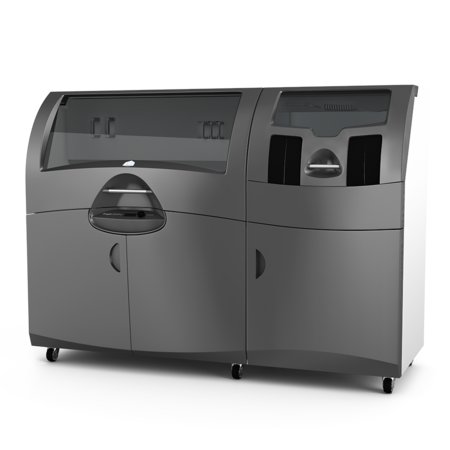"It's simple to use ... three of us learned everything we needed to know in less than a day, and a fourth learned by watching us. We don't have to jump through hoops if we want to print something. Bam! We just print it. I don't have to ask anybody." - Andy Johnson, Industrial Designer, Powermate
Aesthetics isn't just for fine art anymore. Consumers care deeply how their products look, even utilitarian ones like Powermate Corp.'s gas-powered air compressors, pressure washers, generators and backup power systems. Plain old rectilinear sheet metal has given way to sleek injection molded plastic parts in these products, not only for function but for improved shelf appeal.
The steadily increasing demand for good-looking plastic parts such as knobs, wheels, handles and control panels has prompted Powermate, a 700-employee company headquartered in Aurora, Ill., to use more prototypes so that design teams can refine look, feel and fit throughout the design process.
Challenge
The Time and Cost of Prototyping
Prior to 2006, obtaining prototypes had been a painful process for Powermate, requiring a week or two for the required executive sign-offs on each purchase order and another week or two to get the part scheduled, made and delivered. The company required the red tape because the cost of prototypes was exorbitant: as much as $2,000 apiece, resulting from expensive fused deposition modeling or selective laser sintering fabrication methods. The company was spending upwards of $75,000 per year on prototypes.
Powermate industrial designer Andy Johnson urged the company to investigate the possibility of purchasing an in-house 3D printer to save time and money in the creation of prototypes. A 3D printer is an output device for 3D computer-aided design (CAD) data in the same way that a 2D printer is an output device for word processing software. The primary difference is that a 3D printer outputs three dimensional models and prototypes.
Solution
In-House 3D Printing
Johnson and his design team investigated 3D printers and selected the ProJet CJP 360 The ProJet CJP 360 creates models directly from digital data in hours instead of days. It is fast, versatile and simple, allowing engineers to produce a range of concept models and functional test parts quickly and inexpensively. The system is ideal for an office environment or educational institution, providing product developers easy access to a 3D printer.
The ProJet CJP 360 was one-eighth the cost of a rival product, and integrates seamlessly with Powermate's SolidWorks® 3D CAD software. The ProJet CJP 360 also has the lowest operating costs in the industry with material costs being one-sixth that of competing solutions.
Results
Time Saved, Costs Reduced and Errors Avoided
"I figure we paid for our ProJet CJP 360 Plus within six weeks," says Johnson. The device has helped the company slash annual prototyping costs to $25,000, with only a few late-stage or outsized prototypes going out to a service bureau. Using the ProJet CJP 360 Powermate engineers can now create prototypes in half a day or, better yet, push the "print" button on the way out the door at night and collect the prototypes when they arrive at work the next morning. Johnson's team, based in the company's Nebraska office, has even begun printing parts for colleagues in the Aurora office who e-mail CAD files and receive their printed prototypes in the mail a day or two later.
Johnson's team is also improving communication with manufacturing partners overseas by sending printed models. This has become possible only because the ColorJet Printing (CJP) technology has made 3D printed models so affordable. Now manufacturing partners understand immediately what Powermate engineers are trying to accomplish, eliminating errors and the weeks of faxes, e-mails and phone calls previously needed to clarify design intent.
"Some of our manufacturing partners are not themselves consumers of the products we make," Johnson said. "So when we send them a full-color printed model, perhaps attached to an existing production part, they understand the design intent a lot better because they can hold it in their hands."
Although it's a sophisticated machine, the ProJet CJP 360 has fit neatly into the Powermate engineering office. "It's simple to use, it doesn't take up a lot of space, it runs off a PC and Microsoft Windows and it uses a regular electrical outlet," says Johnson. "Three of us learned everything we needed to know in less than a day, and a fourth learned by watching us operate it."
Powermate uses the ProJet CJP 360 to make three or four parts per week and expects that number only to climb over time. The company occasionally uses it to create presentation models for customers. After painting the parts, customers are often convinced they're looking at finished parts, says Johnson. And for the first time, the company can create a physical model of a stamped sheet metal part without taking all the steps that would be required to create the production part. Powermate is interested in using the ProJet CJP 360 in the future to make patterns and molds for cast aluminum and cast iron parts, such as exhaust manifolds.
The biggest advantage, however, is being felt here and now: "We don't have to jump through hoops if we want to print something," Johnson says. "Bam! We just print it. I don't have to ask anybody."
